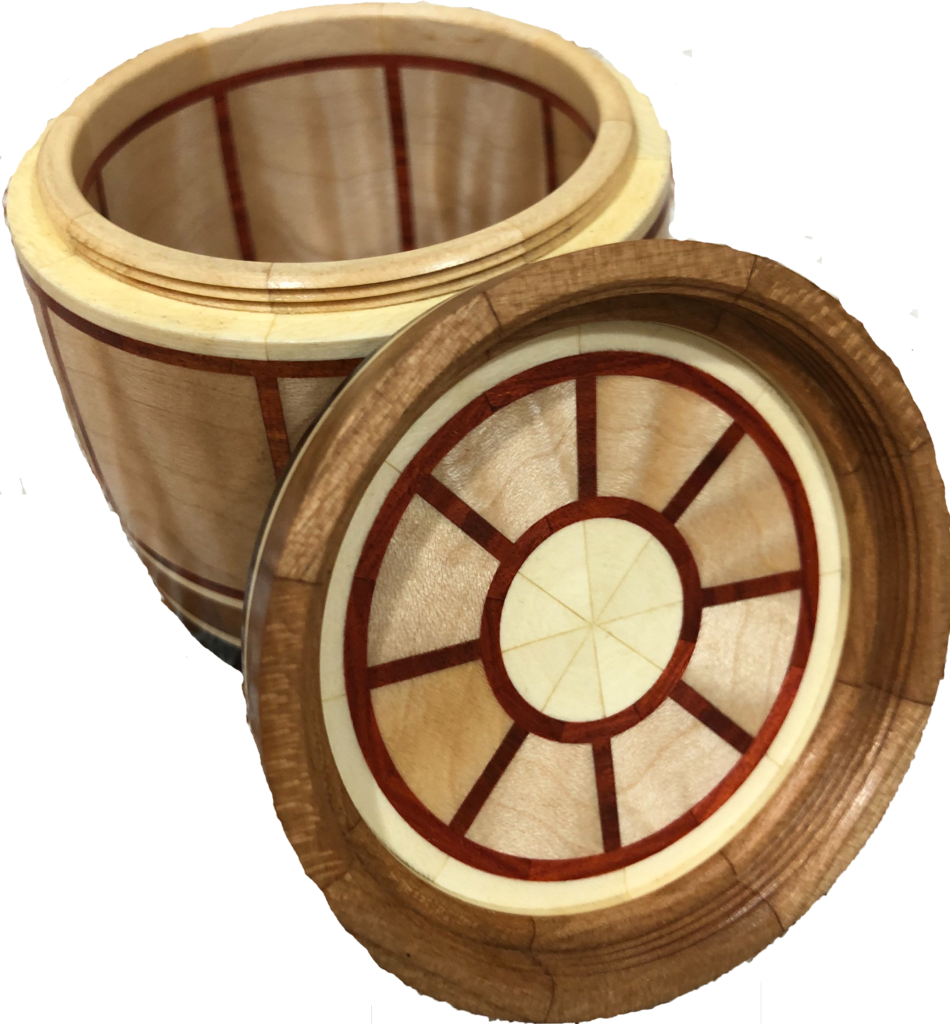Threading Wood For Every Day Woodturning

This video is also posted on YouTube, Vimeo, and Facebook. Best right here!
We have a special guest for this week’s video. Frank Young is a master woodturner. He will show hand chasing threads in segmented wood for all sorts of projects.
Why threads in segmented wood?
Usually when someone is chasing threads, they must use very hard, close-grained wood. Typically, these are exotic tropical hardwoods and very expensive. Some, like boxwood, have become scarce and only available in small dimensions.
What makes these hardwoods well suited for chased threads? Their wood is dense and strong to hold threads threaded on end grain.
But, what if we can expand threading to more common and less expensive domestic woods? The problem is that threads in these woods are not strong and quickly break away.
The solution is to only use the side grain in these woods. With side grain threads, the grain structure better supports the threads making them less brittle and well suited to supporting the threads.
How to use only side grain? Simple. Cut the wood into trapezoidal segments and glue them together like segmented vessels. Voila, side grain.
Not only side grain, but side grain of any diameter, any height.
What if my project is of solid wood? Easy, make the threads separately then glue the threaded segments into the near finished project – an insert.
The final advantage. Threading can be separate from the main project. If the threads get messed up, the project is not ruined. Simply remake the threads and continue.
There’s more but start and explore the possibilities. Plus, domestic woods are more sustainable than tropical rain forest woods.
Frank Young is my guest turner.
Enjoy!
what threading tools are being used to make the threads
Please look again at the last picture before the ending for all the tools he used and pause the video.
Alan
How does Frank decide the thread size to use?
Most of us cannot afford chasing tools for a lot of different TPI’s.
As you can see with the last picture, he used 20 tpi for these threads. It’s a good starting point.
Alan
Definitely a better way to go. Thanks for the info.
You’re welcome – glad to do it.
Alan
Sorry Alan – but, this is one of the worst videos I have seen from you. It is not to your usual standard.
Apologies, if I have mis-understood its purpose.
I accept that Frank is a master turner – and he certainly achieved the required result.
BUT, in the video, there was minimal actual instruction – tooling?, TPI?, very little commentary as to what was happening – no technique (apart from the RPM) – no mention of the use of the arm-rest.
Hand chasing is a huge/ difficult(?) subject – it is worthy of a proper instructional video, not just a simple demonstration.
Regardless, keep up the good work! Thank you.
Sorry, it missed for you. If you have experience hand chasing, what are your roadblocks?
Alan
Is there a need to strengthen the treads with crazy glue to keep the threads true??
John 😀
That is one of the most significant advantages of the segmented approach.
No CA glue needed unless you’re using wood with “crazy” grain. Even then, use cherry or maple or poplar as an insert.
Alan
Not very informative. More explanation was needed.
Actually, Frank targeted it to people already familiar with hand chasing.
There is a lot more to learn but mostly in training your hands to behave.
Alan
Hi!
Very educational and interesting video.
Would You , maybe with another video, give info about dimensioning the threads etc? So eg how to choose tpi, considering the diameter of a box and lid? How to plan the male and female diameters when beginning the threading operation, please?
Thank you for the specific suggestions. We’ll work on it.
Alan
Alan, tell Mr. Young thanks for sharing the technique. I now see that segmenting is a way, possibly the only way, to get consistent threading. Thanks again!
—Joe
Will DO.
Alan
Alan, my daughter recently gave me a Robert Sorby threading tool set as a present, which I have yet to put to use. It has excellent instructions included. Those instructions, along with Frank’s demo, should set me on a good path. I especially like Frank’s idea of turning the threads separate from the body of the project.
Now it should only take some practice. 🙂
Alan
For me, this was a wonderful example of the possibilities “out there” for a beginner wood-turner. I’m continually amazed at what experts can do with their tools. Thanks for increasing my wood-turning vision.
You are welcome.
Alan
Right on as hand threading for most domestic woods and even exotics is only possible with the grain not practical unless your segmenting for that reason I use the threading jig from Chefware Kits, problem solved.